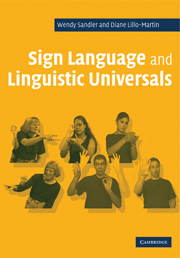Book contents
- Frontmatter
- Contents
- Preface
- Notation conventions
- UNIT I INTRODUCTION
- UNIT II MORPHOLOGY
- 2 Morphology: introduction
- 3 Inflectional morphology
- 4 Derivational morphology
- 5 Classifier constructions
- 6 Entering the lexicon: lexicalization, backformation, and cross-modal borrowing
- 7 Morphology: conclusion
- UNIT III PHONOLOGY
- UNIT IV SYNTAX
- UNIT V MODALITY
- References
- Index
7 - Morphology: conclusion
Published online by Cambridge University Press: 05 June 2012
- Frontmatter
- Contents
- Preface
- Notation conventions
- UNIT I INTRODUCTION
- UNIT II MORPHOLOGY
- 2 Morphology: introduction
- 3 Inflectional morphology
- 4 Derivational morphology
- 5 Classifier constructions
- 6 Entering the lexicon: lexicalization, backformation, and cross-modal borrowing
- 7 Morphology: conclusion
- UNIT III PHONOLOGY
- UNIT IV SYNTAX
- UNIT V MODALITY
- References
- Index
Summary
If we were to approach sign language morphology from a simplistic and surface-oriented viewpoint, we would be confounded at once. Most of the word formation in sign languages does not consist of the linear affixation of concrete morphemes that bear a one-to-one correspondence with a meaning or grammatical function. Instead, the morphology of sign languages lends support from a different modality for the contemporary generative view of morphology – a morphological component that is word-based, and involves forms and processes that are often abstract and are not necessarily concatenative. Verbal bases may be associated to partially specified skeletal templates to form various verbal aspects; certain verbal forms may be reduplicated and their movements altered to derive nouns; classifier morphemes associate non-concatenatively to movements and locations to create complex forms that depict locative relations and different path shapes and manners of motion.
Classical morphological properties are also found in sign languages. There are sequential affixes that evolved diachronically from free words in the sign languages we have studied. Derivation, inflection, and compounding are all attested in many sign languages. This means that productive word-internal processes for forming new lexemes and for marking syntactic relations among words are robust in sign languages, as they are in most spoken languages – a significant discovery for defining the human language faculty. The sign language system supports allomorphy as well – more than a single form for the same word partial.
- Type
- Chapter
- Information
- Sign Language and Linguistic Universals , pp. 108 - 110Publisher: Cambridge University PressPrint publication year: 2006



